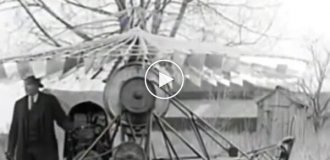
YTB-3 on Gorky Street (Tverskaya). Photo from the 1930s.
The first trolleybus was created in 1882 in Germany by Werner von Siemens. The pilot line was built in the city of Insterburg (now Chernyakhovsk, Kaliningrad region). The first regular trolleybus line was opened in the Berlin suburb of Galensee on April 29, 1882.

1882 Germany.
The contact wires were located at a fairly close distance, and short circuits occurred due to strong winds. The first trolleybuses did not have booms; For current collection, a trolley was used, which either rolled freely along the wires due to the tension of the cable, or had its own electric motor and moved with its help in front of the trolleybus. Later, rods with wheeled and later sliding current collectors were invented.

One of the first English trolleybuses in Leeds. 1911

On the line in Czechoslovakia. Photo from the 1900s.
In 1902, the magazine "Automobile" published a note about tests of "a car driven by electrical energy received from wires along the track, but running not on rails, but on an ordinary road." The car was intended for transporting goods. This happened on March 26, 1902, and this day can be considered the birthday of the domestic trolleybus. The crew was manufactured by Peter Frese, and the engine and electrical equipment were developed by Count S. I. Schulenberg.
Judging by the descriptions, it was a fifty-pound carriage, operating from a line with a voltage of 110 volts and a current of 7 amperes. The crew was connected to the wires by a cable, and at its end there was a special cart that slid along the wires as the crew moved. During tests, “the car easily deviated from the straight direction, backed up and turned.” However, then the idea was not developed and the freight trolleybus was forgotten for about thirty years.

The first trolleybus from Frese and Co. 1903 St. Petersburg.
A trolleybus first appeared in Moscow in 1933. Traffic on the first route, at that time “single-track”, from Tverskaya Zastava (Belorussky Station) to the village of Vsekhsvyatskoye (now the area of the Sokol metro station) opened on November 15, 1933. In Moscow, the idea of building a trolleybus line was first expressed in 1924, but its implementation began only 9 years later. In December 1932, domestic factories were entrusted with the design and construction of the first two experimental Soviet trolleybuses. In the summer of 1933, the Yaroslavl Automobile Plant, according to a project developed at the Research Institute of Automotive Industry, began producing chassis (based on the Y-6 bus). In October they were sent to the automobile plant named after. Stalin (ZIS, now AMO-ZIL), where they were fitted with bodies manufactured here. By November 1, 1933, two newly released trolleybuses, which received the index "LK" (Lazar Kaganovich), were towed from the ZIS to the Dynamo plant, where electrical equipment was installed on them (current collection was carried out using rollers). The first technical tests of the machines were carried out on the territory of this plant.
The first Soviet trolleybus had a wooden frame with metal sheathing, a body 9 m long, 2.3 m wide and weighing 8.5 tons. It could reach a maximum speed of 50 km/h. The cabin had 37 seats (the chairs were soft), mirrors, nickel-plated handrails, luggage nets; Electric heaters were installed under the seats. The doors were opened manually: the front doors were opened by the driver, the rear doors were opened by the conductor. The cars were painted dark blue (with a creamy yellow stripe at the top and a bright yellow outline at the bottom). Shiny metal shields with the inscription “From workers, engineers and employees of the State Automobile Plant named after Stalin, the Dynamo plant, the Yaroslavl Automobile Plant, NATI” were attached to the frontal part of the body. In October 1933, a single-track trolleybus line was installed along the Leningradskoye Highway from Tverskaya Zastava to the Okruzhnaya Railway bridge in Pokrovsky-Streshnevo. On November 5, the secretary of the Moscow Committee of the All-Union Communist Party of Bolsheviks, N. Khrushchev, was present at the testing of this trolleybus, and on November 6, an official visit of the acceptance committee, consisting of the Chairman of the Moscow City Council N. Bulganin, engineers, technicians and workers who manufactured the trolleybuses, took place along the line. From November 7 to November 15, drivers underwent driving practice in a single car.
Regular service of the only trolleybus began at 11 a.m. on November 15, 1933. The next day, its operating hours were determined - from 7 a.m. to 12 p.m. The average speed was 36 km/h, and the car covered the entire line in 30 minutes. This is how the first trolleybus line was opened in Moscow and the USSR.
Mass production of trolleybuses was established three years later in Yaroslavl.

The first Moscow trolleybus, 1933
“The double-decker trolleybus is a great success among Muscovites. There are too many people who like to ride “higher”. The second floor is always crowded with adults and children. Some citizen, apparently desperate to find a place on the second floor, climbed the stairs to the roof of the trolleybus.
-Where are you going, citizen? - I shouted. - Go! They haven't made a three-story trolleybus for you yet. The citizen looked at me with pleading eyes and said in despair: “What should I do?” The second floor is crowded, but the roof is vacant. I can't leave Moscow without taking a high-altitude trolleybus ride. I had to take the whistle."
From the newspaper "Moscow Transportnik" dated November 7, 1939.

YATB-3.
In 1935, one double-decker trolleybus was purchased from the English Electric Company. “On the instructions of N.S. Khrushchev, a double-decker trolleybus of the newest type has been ordered in England and will arrive in the near future,” wrote “Working Moscow” on January 8, 1937. — It has a metal body, a three-axle chassis, 74 seats, and weighs 8,500 kg. The silent operation of the main units of English cars, the rear axle, the engine, the motor-compressor, the pantographs, as well as the smooth start and stop are the result of a carefully thought-out design and impeccable installation.”
“Muscovites looked in amazement at the huge trolleybus. Almost all passengers wanted to get to the second floor. The driver, Comrade Kubrikov, speaks well of this trolleybus,” wrote the newspaper “Moscow Transportnik” on September 3, 1937. “It’s a wonderful car. The controls are very easy and obedient. We thought that due to its bulk the machine would not be stable, but our fears turned out to be unnecessary.”

The trolleybus was delivered by sea to Leningrad, and its transportation to Moscow turned into a whole epic! Due to the enormous size of the double-decker trolleybus, the railway workers categorically refused to accept it for transportation. From Leningrad to Kalinin (Tver) he was towed along the highway (there is no need to explain what this highway was like in 1937). Only on June 29, 1937, the two-story building arrived in Kalinin. Here the car was loaded onto a barge and in early July delivered to the capital, to the second trolleybus depot, where preparations for testing began. During the investigation, interesting details began to emerge. It turned out that, despite its enormous size, the “foreigner” is not so roomy! Due to the high center of gravity, passengers on the second floor were strictly forbidden to stand while moving. With an impressive body height (4.58 m), the ceiling heights on the first and second floors were 1.78 and 1.76 m, respectively, so standing on the first floor was also very difficult even for a person of average height. The trolleybus had only one door for boarding and disembarking passengers - the rear one. It had neither a front platform nor a front door.

The specifics of urban transport in London had nothing in common with Moscow. In the English capital, public transport, even during rush hours, did not know what a crowded cabin was. And the small number of passengers made it possible to get by with one door. In the 30s in Moscow, even at off-peak times, buses, trolleybuses and trams were often simply bursting at the seams.
The shortcomings of the double-decker trolleybus did not end there. It turned out that the contact network of the Moscow trolleybus was unsuitable for the operation of imported cars - it needed to be raised by a whole meter.

YATB-3.
The main thoroughfare of pre-war Moscow—Gorky Street and Leningradskoe Highway—were chosen as a “testing ground.” The contact network was raised. Trial operation began in September and lasted about a month. In October, the “double-decker” was towed to the Yaroslavl Automobile Plant, which was the main supplier of trolleybuses in the USSR in the pre-war years. Here it was disassembled, carefully studied and actually copied. The Soviet analogue of the English trolleybus received the designation YATB-3 - Yaroslavl trolleybus, the third model. It was not possible to create a complete analogue of the “Englishman” - the Soviet trolleybus turned out to be heavier. It weighed 10.7 tons.
Double-decker trolleybuses from Yaroslavl began arriving in Moscow in the summer of 1938. The “Englishman” also returned. In Moscow, all double-decker trolleybuses were concentrated in the first trolleybus depot. Initially they ran between Okhotny Ryad and the Northern River Station. After the opening of the All-Russian Agricultural Exhibition in September 1939, double-decker trolleybuses took to the route connecting the country's main exhibition with the center of the capital.
Having conscientiously translated the operating instructions for a double-decker trolleybus into Russian, Moscow trolleybus operators were surprised to discover that it allowed passengers to smoke in the second floor cabin! “Smoking on the second floor of a double-decker trolleybus causes dissatisfaction among non-smoking passengers,” wrote Moscow Transportnik on February 14, 1940. “The management of the Mosttrolleybus trust should have banned smoking in trolleybuses.”

YATB-3.
Released in 1938 - 1939. a pilot batch of 10 “double-deckers”, the Yaroslavl Automobile Plant stopped their production. The reason is usually given as the looming threat of war. In fact, until August 1941, the Yaroslavl Automobile Plant continued to produce single-decker trolleybuses. After this, the production of civilian products was curtailed, and the production of weapons, ammunition and artillery tractors began. Other reasons for the cessation of production of “two-story buildings” look more convincing. This was due to the obvious unsuitability of their design for work on Moscow streets. Even the appearance of a front door in the back of the trolleybus did not help. Try standing inside a car bouncing on potholes with a ceiling height of 178 cm! And the most important reason is that back in January 1938, N.S. Khrushchev was appointed first secretary of the Central Committee of the Party of Ukraine. There was simply no one to “push” double-decker trolleybuses into the capital.

YATB-3. Lower salon.

YATB-3. Upper salon.
Not a single “two-story building” was evacuated from Moscow. It was impossible to transport them by rail, and even more so to tow them by tractors over hundreds and thousands of kilometers, since in the fall of 1941 each tractor was literally worth its weight in gold.

YATB-3 on Gorky Street. Autumn 1941
Veterans of the first trolleybus park recalled that in October 1941 they received an order: as soon as fascist motorcyclists appeared at the gates of the park, the double-decker trolleybuses would be doused with kerosene and set on fire. For this purpose, barrels of kerosene and tanks of rags were placed near the cars and a special duty officer was appointed. Fortunately, the fascist motorcyclists never showed up at the park gates, falling just a few kilometers short.

YATB-3.
In the post-war years, double-decker trolleybuses were excluded from service. Experience in operating these machines has shown that they are poorly suited for our regions. Newer trolleybuses were single-decker, designed to carry a large number of passengers (mainly standing). It was decided to abandon the use of double-decker trolleybuses in favor of articulated vehicles. But these appeared only in the late 50s from the gates of the SVARZ plant. Not a single copy of the YATB-3 trolleybus has survived to this day.
The last two “double-deckers” were written off in 1953, although these cars, which had all-metal bodies, could last longer. What was the reason?
At one time there was a legend in circulation that Joseph Vissarionovich was traveling from the Kremlin to his dacha in Kuntsevo, and in front of his Packard there was a double-decker trolleybus, swaying from side to side. And it seemed to the leader of all nations that the “two-story building” was about to fall on its side. And Comrade Stalin ordered to eliminate such trolleybuses.
This popular version has nothing in common with the truth, if only because, when traveling between the Kremlin and the Near Dacha, Stalin’s motorcade could never intersect with the route of a double-decker trolleybus.
Another version says that the double-decker trolleybuses were taken out of service after a number of capsizes, accompanied by a large number of casualties. The author of the article even met with several “witnesses” of such disasters. However, when they named the places of incidents, it became clear that nothing like that could have happened there because the trolleybus lines in the indicated places were unsuitable for the movement of double-decker cars. By the way, the archives also found no evidence of the “two-story buildings” overturning. This is largely due to the fact that they were operated in strict accordance with the instructions. The conductors prevented the cars from being overloaded and were especially careful about filling the second floor.

YATB-3.
But the most plausible reason, it seems to me, is the following: for normal operation of double-decker trolleybuses, it was necessary to raise the contact network by one meter. It was this meter that destroyed them! After all, there was not a single line in Moscow that was fully serviced by “two-story workers.” And they were operated in parallel with conventional, single-decker trolleybuses. But while a double-decker trolleybus ran well under a raised overhead contact line, the same cannot be said about single-decker trolleybuses. “Working on a simple “yatebashka” under such a raised contact network is not even work, but sheer torture,” one of the veterans of the Moscow trolleybus told the author of this article (Mikhail Egorov - d1). — On these lines, an ordinary trolleybus is almost tightly tied to the wires, like a tram to the rails! Don't get to the stop! Don't go around a stopped car! And the rods began to fly off the wires more often. There are continuous complaints from passengers. If only Khrushchev had been allowed to drive such a machine, we probably wouldn’t have any double-decker trolleybuses!”
So, once on a line with a raised contact network, a single-story trolleybus was almost completely deprived of one of its most important qualities - maneuverability. By the beginning of the Great Patriotic War, there were 11 “two-story buildings” in Moscow. And ordinary, one-story cars - 572 units! How many drivers and passengers of the Moscow trolleybus cursed the double-decker trolleybuses and their hapless “godfather” every day?!
London transport workers did not have such problems - all trolleybuses there were double-decker.
True, after the war, Moscow specialists tried to increase the maneuverability of single-story machines by installing elongated pantograph rods on them. This experiment ended in complete failure - when a trolleybus with elongated rods moved at their ends, vibration arose, which tore the rods off the wires. By the way, for this reason it is impossible to increase the length of trolleybus bars beyond what they have today. So Moscow transport workers had only two options: either all trolleybuses and trams would be single-decker, or, as in London, double-decker. There is no third. Moscow, as you know, took the first path.
Well, although this is not a trolleybus, nevertheless, I decided to show you this interesting vehicle here:

German bus-trailer.
In 1959, two German Do54 buses and one double-decker passenger trailer for the DS-6 tractor appeared in Moscow, of which only 7 were built in the GDR. The total length of such a trailer with a tractor was 14,800 mm, of which the trailer itself accounted for 112,200 mm. On the first floor of the trailer there were 16 sitting and 43 standing places, on the second - 40 sitting and 3 standing. The first floor was connected to the second by two 9-step staircases. The height of the cabin on the first floor is 180 cm, on the second - 171 cm. The diesel engine of the tractor has a power of 120 hp. allowed this design to reach a speed of 50 km/h. Initially, this trailer, along with two double-decker buses, ran on route No. 111 from the Oktyabrskaya metro station to Moscow State University, and then all three cars were sent on the route from Sverdlov Square to Vnukovo Airport. These cars were driven until 1964.

The first Soviet freight trolleybuses began to appear in the 30s. last century. These were handicraft converted passenger nuclear safety vehicles. Such trucks were used for the own needs of trolleybus depots.

Gradually, the scope of application of such machines began to expand and operators began to think about using “horned” machines in those places where there was no contact network. This problem became especially urgent in conditions of fuel shortages during the war.

Freight trolleybus on Gorky Street. Photo 1941
In particular, in the capital of the USSR, on the initiative of the director of the 2nd trolleybus fleet, I. S. Efremov, the first real cargo trolley cars were built - trolleybuses equipped with an additional set of batteries, thanks to which they could deviate considerable distances from the contact network. According to some reports, such machines operated in Moscow until 1955.
The next step was the creation of trolleybuses equipped, in addition to an electric motor, with internal combustion engines. Such machines could deviate from the wires over even greater distances, although they did this extremely rarely. Experiments with such machines in the late 1950s. At first it was installed by the Uritsky plant, the main manufacturer of trolleybuses in the USSR, but its cargo trolleybuses remained single prototypes. Freight trolleybuses were introduced to the masses by another plant - Sokolnichesky Car Repair Plant, better known as SVARZ.

Freight trolleybus "from childhood". It was precisely these trolleybuses, full of toys, that called into the basements of Detsky Mir.
They were equipped with two parallel drive systems - from an internal combustion engine and from an electric motor. The basis of the first 5-ton version of the TG was an original spar frame, on which a high van body with two side sliding doors and a rear double-leaf door, four windows in the roof and a spacious double cabin was installed. The TG-4 variant had an on-board platform. The trolley carriers were equipped with a 70-horsepower gasoline engine, a gearbox, a radiator lining from a GAZ-51 car, axles and wheels from a MAZ-200, and electrical equipment from an MTB-82D trolleybus with a DK-202 traction motor with a power of 78 kW. Since 1964, the TG-3M trolley car was produced with the electrical equipment of the ZiU-5 trolleybus and the DK-207 motor (95 kW). Externally, it was distinguished by a radiator grille and the absence of windows in the cargo compartment. The total weight of the vehicles was about 12 tons. They reached speeds of up to 50 km/h. Until 1970, SVARZ produced about 400 freight trolleybuses, including 55 examples with an on-board platform. 260 of these machines operated in Moscow. The latter was “retired” in 1993. 140 SVARZ freight trolleybuses operated in other cities of the USSR, including Minsk.
In the 1970s The initiative of SVARZ was intercepted by the Kiev Electric Transport Plant named after F. E. Dzerzhinsky, also known as KZET. The circulation of its cargo trolleybuses of the KTG family significantly exceeded the figures of SVARZ, and many of those vehicles are still in operation. At first, KZET was supposed to produce not only a van and an onboard truck, but also a whole family of trolley cars, including a water washer, a refrigerated van, a dump truck and even a truck tractor. But the projects remained projects.



Freight trolleybus based on BELAZ.
And to make amends - the well-known SVARZ trolleybus:






















